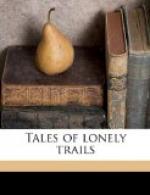That night we camped at Bubbling Spring, which once had been a geyser of considerable power. Wetherill told a story of an old Navajo who had lived there. For a long time, according to the Indian tale, the old chief resided there without complaining of this geyser that was wont to inundate his fields. But one season the unreliable waterspout made great and persistent endeavor to drown him and his people and horses. Whereupon the old Navajo took his gun and shot repeatedly at the geyser, and thundered aloud his anger to the Great Spirit. The geyser ebbed away, and from that day never burst forth again.
[Illustration: Weird and wonderful monuments in Monument valley]
[Illustration: Sunset on the desert]
[Illustration: Cave of the cliff dwellers]
Somewhere under the great bulge of Navajo Mountain I calculated that we were coming to the edge of the plateau. The white bobbing pack-horses disappeared and then our extra mustangs. It is no unusual thing for a man to use three mounts on this trip. Then two of our Indians disappeared. But Wetherill waited for us and so did Nas ta Bega, the Piute who first took Wetherill down into Nonnezoshe Boco. As I came up I thought we had indeed reached the end of the world.
“It’s down in there,” said Wetherill, with a laugh.
Nas ta Bega made a slow sweeping gesture. There is always something so significant and impressive about an Indian when he points anywhere. It is as if he says, “There, way beyond, over the ranges, is a place I know, and it is far.” The fact was that I looked at the Piute’s dark, inscrutable face before I looked out into the void.
My gaze then seemed impelled and held by things afar, a vast yellow and purple corrugated world of distance, apparently now on a level with my eyes. I was drawn by the beauty and grandeur of that scene; and then I was transfixed, almost by fear, by the realization that I dared to venture down into this wild and upflung fastness. I kept looking afar, sweeping the three-quarter circle of horizon till my judgment of distance was confounded and my sense of proportion dwarfed one moment and magnified the next.
Wetherill was pointing and explaining, but I had not grasped all he said.
“You can see two hundred miles into Utah,” he went on. “That bright rough surface, like a washboard, is wind-worn rock. Those little lines of cleavage are canyons. There are a thousand canyons down there, and only a few have we been in. That long purple ragged line is the Grand Canyon of the Colorado. And there, that blue fork in the red, that’s where the San Juan comes in. And there’s Escalante Canyon.”
I had to adopt the Indian’s method of studying unlimited spaces in the desert—to look with slow contracted eyes from near to far.




